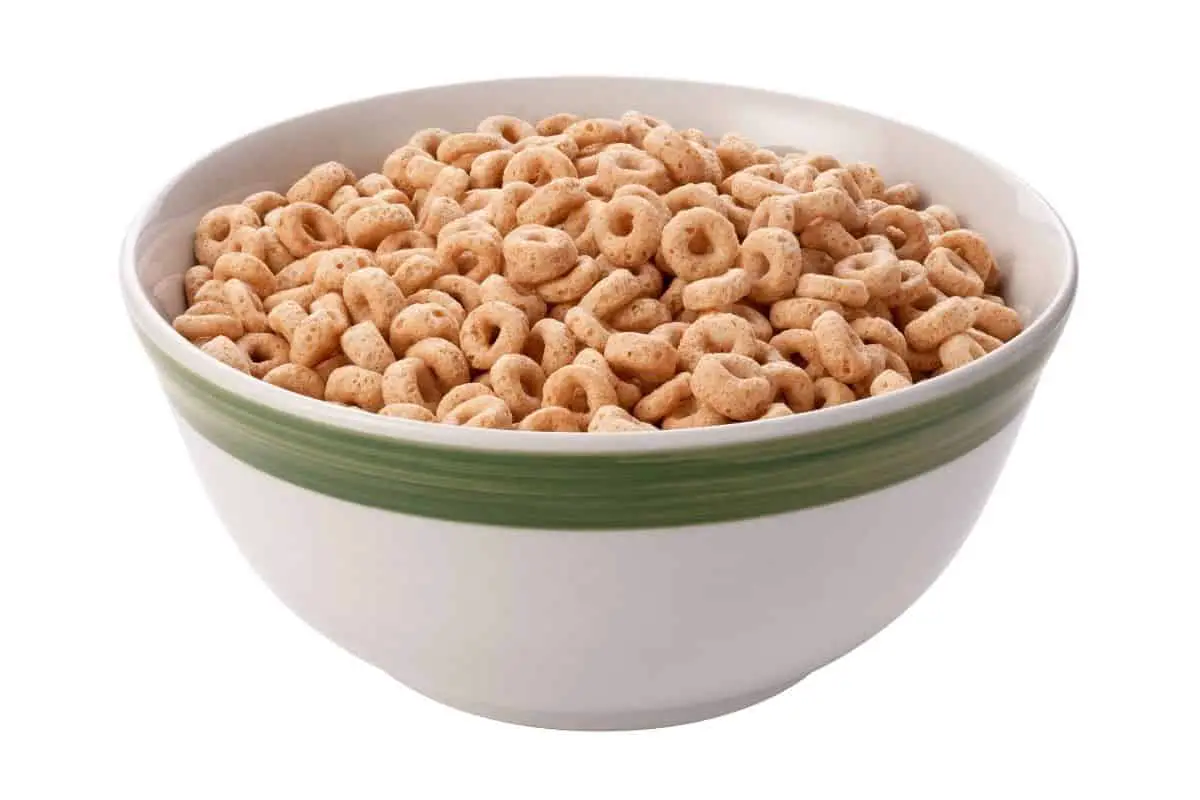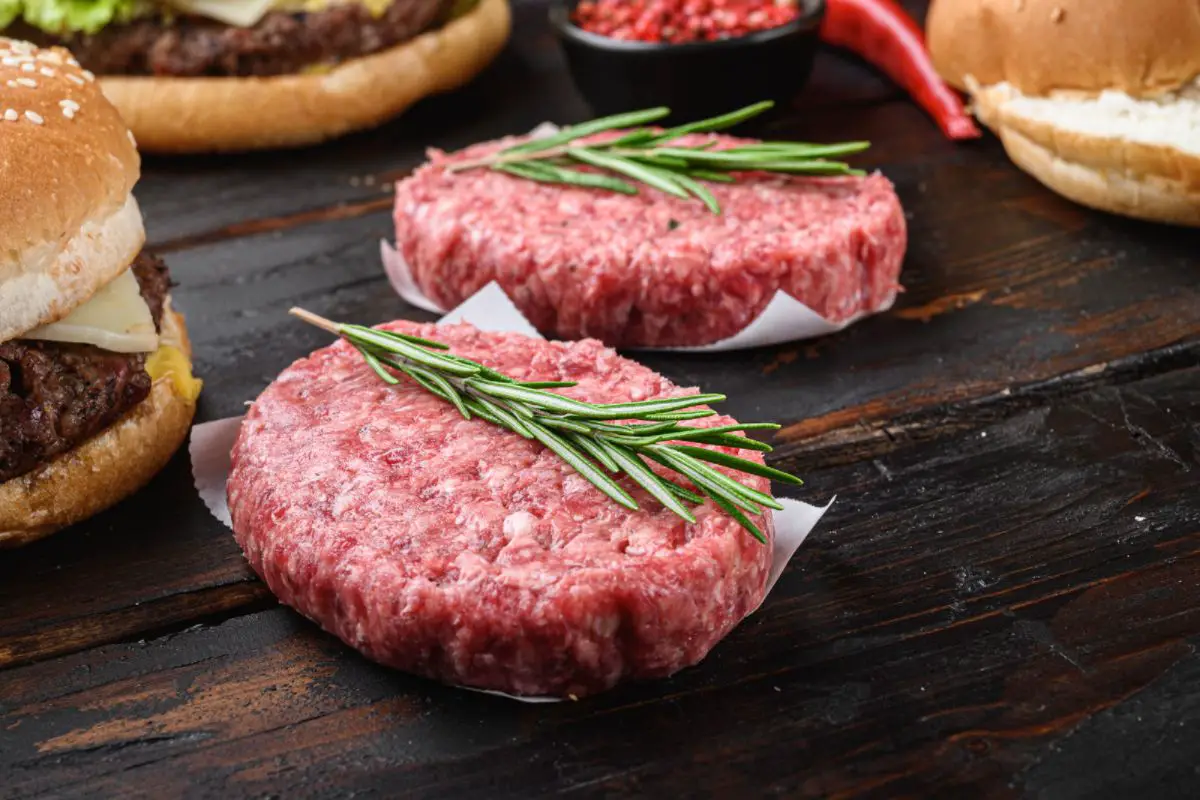This post contains affiliate links.
Cheerios are a common breakfast food that many of us enjoy. They can also be tasty as a snack – so tasty that you may be wondering if you can share their deliciousness with your favorite furry friend.
Dogs can safely eat Cheerios as a treat or training tool. However, you should only feed your dog plain Cheerios, and avoid chocolate, frosted, or flavored Cheerios. You should also only feed Cheerios to dogs in moderation, as they have no nutritional value and can cause weight gain.
To learn more about feeding your dog Cheerios, including how much you can feed him, how often, and what kind of Cheerios are best, read on.
Table of Contents
What Kind of Cheerios Are Safe for Dogs?
Although dogs can safely consume Cheerios, they are not a snack that you should feed your pet regularly. Cheerios should only be given to a dog in very small amounts and only as a treat or training tool. Cheerios do not contain the right nutritional value to replace proper dog food.
The plain variety of Cheerios are the safest to give to dogs because they contain less sugar and artificial ingredients. Plain Cheerios don’t contain cocoa or nuts, which are toxic to dogs. For this reason, you also should refrain from feeding your dog chocolate or flavored Cheerios.
How Many Cheerios Can Dogs Eat?
If you are using Cheerios as a treat or a training tool for your dog, you should only give him very small amounts. Give your dog one Cheerio at a time to test for any adverse reactions before feeding more.
Dogs can eat a small handful of Cheerios every couple of days, but you should limit their consumption as much as possible. They should not be consuming Cheerios daily or as a replacement for their regular dog food.
There are two reasons for this. First of all, you don’t want to give your dog too many Cheerios because it can be bad for his overall health. Secondly, you don’t want your dog to become too reliant on treats or expect them all the time, as that can lead to behavior problems.
Are Cheerios Bad for Dogs?
Cheerios can be bad for dogs, even when only fed to them in very small amounts. The sugar and carbohydrates in Cheerios can cause UTIs and digestive problems, and too many Cheerios can also lead to weight gain.
Let’s take a look at some of the potential risks involved with feeding your dog Cheerios.
Cheerios Can Cause UTIs
Feeding a dog too many products containing sugar and carbohydrates, such as Cheerios, can cause them to suffer from a urinary tract infection (UTI). UTIs can cause kidney and bladder problems for your dog and must be treated by a vet.
Common symptoms of a UTI in dogs are:
- Difficulty passing urine
- Bloody or cloudy urine
- Frequent urination
- Urine with a strong odor
- Licking privates
Cheerios Can Cause Gastrointestinal Problems
Some dogs can have very sensitive stomachs, and Cheerios can prove to be too much for them. The first time you give your dog Cheerios, keep an eye on him to make sure the treat doesn’t make him sick. If you know that your dog has a sensitive stomach already, avoid giving him Cheerios altogether.
Another problem that can arise from feeding your dog Cheerios is giving him the cereal with milk. It may be tempting to give your dog the leftovers of your breakfast, but you really should avoid it. Most dogs are also lactose intolerant. Too much milk can cause a dog gastrointestinal distress such as vomiting and diarrhea, leading to complications such as severe dehydration.
Cheerios Can Make Your Dog Overweight
This probably goes without saying, but dogs that constantly receive treats (of any kind, not just Cheerios) are at risk of becoming overweight. Weight-related issues that can affect your dog include pancreatitis, diabetes, heart issues, and joint problems. Therefore, it’s important to only give your dog treats sparingly.
Cheerios Can Cause Dental Problems for Your Dog
Cheerios are well-known for having less sugar than other types of cereal; however, that doesn’t mean they have no sugar. Any amount of sugar is not good for your dog, as it isn’t part of their natural diet.
Dogs also can’t clean their teeth unless you do it for them, so any tartar build-up because of sugary treats can wreak serious havoc on their teeth and gums. This is why you should always steer clear of the more sugary types of Cheerios, like the frosted or yogurt-covered varieties.
Some Flavors of Cheerios Can Be Toxic to Dogs
Most dog owners know that chocolate and caffeine are poisonous to dogs and should be avoided at all costs. Therefore, you should never feed your dog chocolate Cheerios.
Sometimes, though, dogs will eat things they shouldn’t. If your dog has eaten chocolate Cheerios, watch for these symptoms, which can appear within 6 to 12 hours:
- Vomiting and diarrhea
- Frequent urination
- Tremors and shaking
- Restlessness
- Collapse
- Seizures
- Elevated heart rate
If you suspect that your dog has been poisoned from eating chocolate, you should take him to the vet immediately because it could be a life-threatening condition.
Cheerios have a wide range of flavors and varieties to choose from, such as Pumpkin Spice, Apple, and even Berries. However, it’s vital that you refrain from feeding your dog any of these flavors because they can contain harmful ingredients that could be toxic to your dog. Nutmeg, for example, can be found in the Pumpkin Spice flavor of Cheerios and is extremely toxic to dogs when consumed in large amounts.
Furthermore, you should avoid giving your dog cereal bars made with Cheerios, or any other variations of Cheerios that use artificial sweeteners like xylitol. Xylitol is another ingredient that is extremely toxic to dogs and can cause similar symptoms to other types of poisonings such as gastrointestinal issues, lethargy, tremors, and seizures.
If you suspect your dog to have eaten Cheerios containing xylitol, monitor him closely for any symptoms and seek assistance from your vet, if necessary.
Are There Other Types of Cereal Dogs Can Eat?
There are other types of cereal dogs can eat, such as Bran Flakes and Corn Flakes. These cereals can be quite good for dogs and can help them overcome intestinal troubles, like constipation. These cereals are also preferred because they don’t contain excessive sugar or artificial additives.
However, they should not be given to dogs with milk because the dairy can upset your pet’s stomach. Instead, moisten the cereal with water and add it to his regular food as an occasional treat.
When Possible, Opt for All-Natural Dog Treats
Instead of relying on potentially sugary cereals as treats for your furry friend, there are safe and tasty alternatives that your dog will enjoy. Dogs can eat whole, raw carrots and they’re much healthier yet offer the same delightful crunch with a hint of sweetness. As an all-natural snack, carrots won’t cause weight gain and are easy on a dog’s teeth as well.
Another great alternative snack is a bully stick, or bull pizzle. Bully sticks are delicious and made from dog-safe ingredients that your pet will love. Bully sticks can help with your dog’s oral hygiene by removing plaque and build-up on the teeth, and can also serve as long-lasting treats to keep your dog occupied for extended periods.
If you’re looking for smaller treats to use during training, try boiling some boneless, skinless chicken and cubing it into small chunks. These can safely be used in place of Cheerios as well.
Final Words
Cheerios are a relatively healthy cereal option for humans, but those health benefits don’t extend to dogs. While a few plain Cheerios every now and then are okay as a treat or a training tool, you should refrain from giving dogs large quantities of the cereal.
Avoid the sugary varieties of Cheerios, and steer clear of the chocolate and frosted flavors. Some cereals are okay to give to dogs more often, such as Bran Flakes.
Ultimately, cereal isn’t a great snack for dogs, and they would benefit more from healthier treats, such as carrots or boiled chicken.
Related Articles
- Can Dogs Eat Salmon Skin? Let’s Find Out!
- Can Dogs Eat Salt and Vinegar Chips (Read This First)
- Can Dogs Eat Molasses? (We Find Out)
- Can Dogs Eat Mulberries? (We Find Out)
- Can Dogs Eat Jello? (We Find Out)
Sources
- Can I Give My Dog: Can Dogs Eat Cheerios?
- PupLore: Can Dogs Eat Honey Nut Cheerios? They Are A Tasty Snack!
- Spoiled Hounds: Can Dogs Eat Cheerios? What to Know About Dogs and Cheerios
- Advanced Care for Pets: Cheerios – Not So Cheery For Your Pet!
- WebMD: Lower Urinary Tract Problems and Infections in Dogs
- American Kennel Club: What to Do If Your Dog Ate Chocolate
- PetMD: Is Nutmeg Safe for Dogs?
- Rover: Can My Dog Eat Cereal
- VCA Hospitals: Xylitol Toxicity in Dogs
Mrdogfood.com is a participant in the Amazon Services LLC Associates Program, an affiliate advertising program designed to provide a means for sites to earn advertising fees by advertising and linking to Amazon.com. We also participate in other affiliate programs which compensate us for referring traffic.




